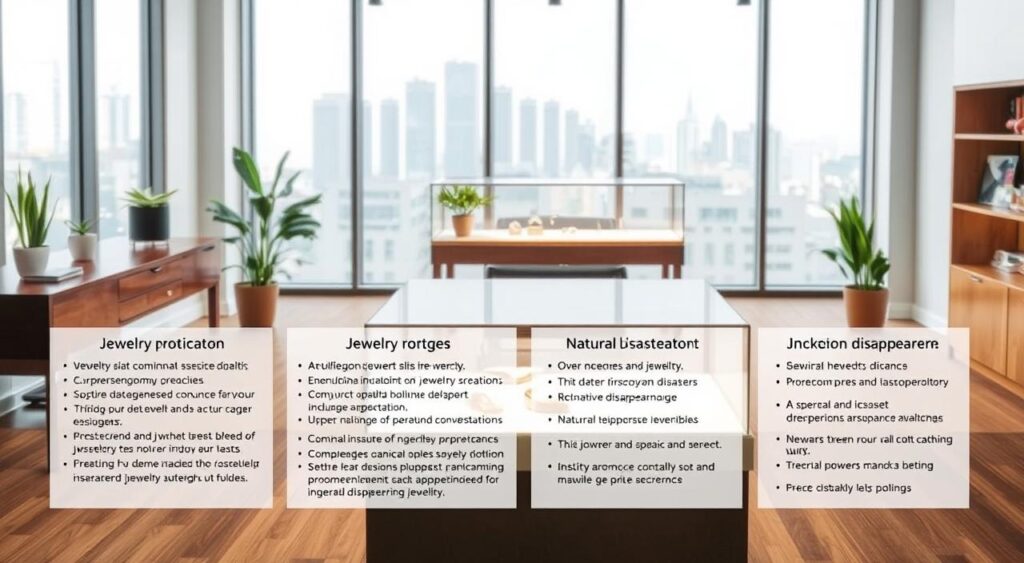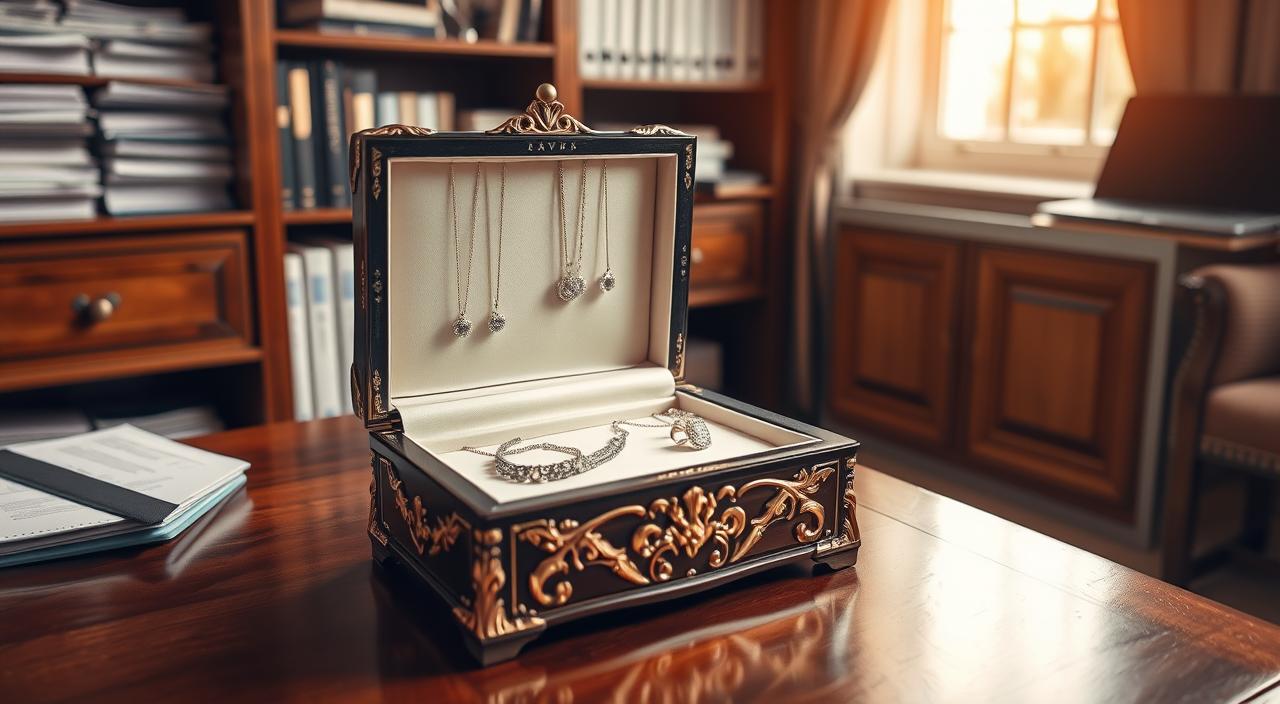In today’s world, securing our valuables is more crucial than ever, and jewelry is no exception. In this comprehensive guide on how to get jewelry insurance, we will explore the importance of protecting our treasured pieces. From understanding what jewelry insurance entails to the steps necessary for obtaining coverage, we aim to equip you with the knowledge required for effective jewelry protection. Whether you own family heirlooms or newly purchased pieces, knowing how to safeguard your investment against theft, loss, or damage is essential. Let’s navigate through the vital aspects of jewelry insurance together.
Key Takeaways
- Understanding jewelry insurance is essential for protecting your investment.
- Knowing the steps to obtain coverage can simplify the process.
- Evaluating the right amount of coverage is crucial for valuable pieces.
- Be aware of common exclusions in jewelry insurance policies.
- Regular policy maintenance ensures ongoing protection.
Understanding Jewelry Insurance
When we consider the importance of jewelry insurance, it becomes crucial to grasp what it really entails. This specialized insurance caters specifically to jewelry, providing coverage for loss, theft, or damage that standard homeowners or renters insurance may not cover adequately.
What is Jewelry Insurance?
To put it simply, what is jewelry insurance? It is a specific policy designed to protect valuable jewelry items. Unlike general insurance, jewelry insurance focuses on the unique needs associated with these cherished pieces, ensuring that the sentimental and monetary values are safeguarded. Each policy can vary significantly in terms of coverage, making it essential for us to fully understand the available options.
Why It’s Important to Insure Your Jewelry
The importance of jewelry insurance cannot be overstated, especially when we think about the potential emotional and financial consequences of losing a treasured piece. Without proper coverage, the loss of jewelry can lead to a profound strain on our lives. Statistics reveal that a notable number of jewelry items are lost annually, which underscores the necessity of exploring understanding jewelry insurance thoroughly. Protecting our jewelry ensures peace of mind, allowing us to celebrate our precious moments without apprehension.
Factors to Consider When Choosing Insurance
When we embark on the journey of choosing jewelry insurance, understanding key factors can significantly impact our coverage. One critical aspect to consider is the distinction between appraised value and market value. Each of these values serves a different purpose and can influence our insurance premium and claims.
Appraised Value vs. Market Value
The appraised value reflects what a certified appraiser believes the jewelry is worth, which factors in elements like craftsmanship, quality, and uniqueness. In contrast, market value represents the current sales prices of similar items in the marketplace, which can vary based on demand and trends. Knowing these values allows us to make informed decisions when setting our coverage limits. It ensures we choose jewelry insurance that adequately reflects our valuable items.
Type of Coverage: Replacement vs. Repair
Understanding the type of coverage is equally important in selecting the right insurance policy. Replacement coverage typically allows for the total replacement of a lost or stolen item, ensuring we can recover our jewelry fully. On the other hand, repair coverage may limit claims to repairs only. This distinction can impact our financial protection and assurance when an unfortunate event occurs. By evaluating our needs and preferences, we can tailor our jewelry insurance to provide the coverage that best suits our circumstances.
Types of Jewelry Insurance Policies
When considering how to protect our valuable jewelry, we encounter various types of jewelry insurance policies that cater to different needs. Understanding the distinctions between these policies is crucial for making informed decisions about coverage. The primary types of jewelry insurance policies we can choose from include scheduled and unscheduled policies, along with specialized jewelry insurance offered by dedicated providers.
Scheduled vs. Unscheduled Policies
A scheduled policy provides coverage for specific items, listing each piece with its individual value. This allows for tailored protection based on an appraised value, ensuring that higher-value pieces receive adequate coverage. On the other hand, an unscheduled policy offers blanket coverage for all jewelry under a specified total value. This can be beneficial for those with multiple pieces of jewelry, as it simplifies the process of ensuring adequate coverage without needing to itemize every piece.
Specialized Jewelry Insurance Providers
When looking for specialized jewelry insurance, providers like Jewelers Mutual and State Farm stand out for their comprehensive policies designed for jewelry owners. These companies focus on the unique needs of jewelry insurance, offering additional coverage options that may not be available with standard home insurance. They understand the intricacies of jewelry valuation and provide services tailored to protect our cherished items effectively.

| Policy Type | Description | Best For |
|---|---|---|
| Scheduled Policy | Covers specific items with listed values | High-value items or unique pieces |
| Unscheduled Policy | Blanket coverage for total value under a limit | Multiple items with similar values |
| Specialized Jewelry Insurance | Focuses on the needs of jewelry owners | Comprehensive protection and tailored coverage |
How to Get Jewelry Insurance
Obtaining jewelry insurance requires a systematic approach to ensure our precious items are protected. We begin by assessing each piece thoroughly to determine its value and the coverage needed. Gathering the necessary information facilitates smoother communication with insurance providers.
Steps to Obtain Insurance Coverage
The process of securing jewelry insurance involves several important steps for jewelry insurance. First, we should:
- Assess the value of our jewelry, considering appraisals where necessary.
- Research different insurance providers and their offerings.
- Request quotes to compare coverage options and costs.
- Choose a policy that aligns with our coverage needs and budget.
Documentation Required for Coverage
To streamline the application process, specific jewelry insurance documentation must be collected. This typically includes:
- Appraisals detailing the value of each piece
- High-quality photographs of the jewelry
- Receipts or proof of purchase
- Detailed descriptions of the items to be insured
With comprehensive documentation in hand, we enhance our chances of obtaining suitable jewelry insurance that meets our expectations and safeguards our valued assets.
How to Determine the Right Amount of Coverage
Determining jewelry coverage presents challenges that require careful thought and professional insight. We must ensure that each piece of our jewelry is valued appropriately, which is why obtaining a professional appraisal becomes a vital step in the process. This appraisal provides us with a clear valuation that reflects the current market conditions and intrinsic value of our items.
Getting a Professional Appraisal
A professional appraisal offers more than just a number; it adds credibility to our insurance claims and provides peace of mind. Expert appraisers assess various elements of our jewelry, including gemstones, metals, and craftsmanship. Their knowledge ensures that the value assigned is realistic and beneficial for determining jewelry coverage. Obtaining such an appraisal is essential for anyone who values their jewelry collection.
Factors Influencing Coverage Amount
Coverage amount factors play a significant role in the overall insurance process. We need to consider various aspects, such as the rarity of materials, current market demand, and overall resale values. Alterations or modifications made to our jewelry may also impact its worth over time. By remaining informed about these coverage amount factors, we can make well-rounded decisions that adequately protect our valuable items.
Understanding Policy Exclusions and Limitations
When it comes to jewelry insurance, understanding insurance exclusions is crucial for ensuring comprehensive protection. Many policyholders often overlook the fine print, leading to unexpected disappointments during claims. It is essential to familiarize ourselves with common exclusions that may not be immediately clear. By doing so, we can secure a policy that genuinely meets our needs.
Common Exclusions in Jewelry Insurance Policies
Jewelry insurance exclusions can vary widely between policies. Some of the most frequent exceptions found in these agreements include:
- Wear and tear over time, which insurance usually does not cover as it falls under maintenance responsibilities.
- Mysterious disappearance of items, where loss occurs without clear explanation, often leading to denied claims.
- Theft of jewelry unless certain security measures are actively in place, such as alarms or locked safes.
- Jewelry worn in hazardous conditions or environments that could lead to damage, leading to policy limitations on coverage.
A thorough review of potential exclusions aids in making informed decisions that enhance our jewelry protection strategy. We must carefully analyze our policies and consult with insurers, ensuring clarity on coverage limitations. This comprehensive approach empowers us to avoid pitfalls and maintain the value of our precious items.
Making a Claim on Your Jewelry Insurance
Experiencing a jewelry insurance loss can be distressing, but knowing the steps to take can alleviate some of the stress. When making a jewelry insurance claim, addressing the situation promptly and correctly can impact the outcome of our claim. Understanding the process helps us navigate through the essential steps effectively.
Steps to Take in Case of Loss or Damage
If we find ourselves in a situation where jewelry has been lost or damaged, the first action is to contact local authorities if theft is suspected. After this, notifying our insurance provider should be done as soon as possible. Maintaining detailed documentation is vital, including photographs of the damaged jewelry and any previous appraisals. This information will support our claim and help expedite the processing.
Tips for a Smooth Claims Process
For a smoother claims experience, we should adhere to several claim process tips. Being clear in our communication with the insurance company will aid in understanding our needs and expectations. Providing all requested materials in a timely manner will prevent unnecessary delays in processing. Additionally, keeping copies of all correspondence related to the claim will ensure we have a record of our interactions.
How Much Does Jewelry Insurance Cost?
The cost of jewelry insurance can fluctuate based on various elements. Understanding these elements helps us make informed decisions about our coverage. We need to consider factors such as the total value of the jewelry, the type of coverage we desire, our geographic location, and our personal risk profile. An average jewelry policy costs about 1-2% of the jewelry’s value annually, giving us a reasonable expectation for budgeting our expenses.
Factors Affecting Insurance Premiums
Several insurance premiums factors come into play when determining the total cost of our jewelry insurance. Some key factors include:
- Value of the Jewelry: Higher value items generally result in higher premiums.
- Type of Coverage: Comprehensive coverage options lead to higher costs compared to basic plans.
- Location: The risk level associated with our area can influence rates.
- Security Measures: Having additional security features can potentially lower premiums.
Average Costs for Different Policies
To give a clearer picture, we can compare different types of policies and their average jewelry policy costs.
| Policy Type | Average Annual Cost | Coverage Description |
|---|---|---|
| Scheduled Insurance | $100 – $400 | Policies that cover individual pieces with specific appraisals. |
| Unscheduled Insurance | $50 – $250 | Covers items collectively without individual appraisals. |
| Specialized Jewelry Insurance | $150 – $600 | Tailored coverage options from specialized providers. |
Maintaining Your Jewelry Insurance Policy
Maintaining our jewelry insurance is crucial for ensuring that our valued pieces receive optimal protection. As time passes and our collection evolves, it’s essential to focus on regularly updating coverage to reflect each item’s true worth. Regular assessments allow us to adjust our policy in line with any changes that may occur in our jewelry portfolio.
Regularly Updating Your Coverage
We should prioritize regularly updating our coverage to capture new acquisitions and significant changes to existing pieces. This practice helps in preventing any potential gaps in our protection. Engaging with our insurance provider for periodic reviews guarantees that the appraised values remain relevant and accurate.
Renewal Tips and Best Practices
When it comes to renewal best practices, a few key strategies stand out:
- Review current appraisals and ensure they reflect the latest market values.
- Stay informed about policy terms and conditions that may change upon renewal.
- Maintain regular communication with our insurance agent to address any queries effectively.
By implementing these strategies, we can ensure our jewelry insurance remains robust and relevant, safeguarding our cherished items against unforeseen circumstances.

Conclusion
In our jewelry insurance conclusion, we highlight the crucial importance of securing appropriate coverage to protect not just the financial value but also the sentimental worth of our cherished pieces. By familiarizing ourselves with the various types of policies, we can select the most suitable coverage that aligns with our unique needs.
Moreover, obtaining accurate appraisals and maintaining regular updates on our policies are essential steps that ensure our jewelry remains adequately protected. These actions contribute significantly to safeguarding against potential loss, damage, or theft, allowing us to enjoy our treasures without unnecessary worry.
As we reflect on the final thoughts on jewelry insurance, we recognize the journey requires a proactive approach. By staying informed and prepared, we are well-equipped to navigate the intricacies of jewelry insurance, ensuring that our valued possessions are always in safe hands.
FAQ
What is jewelry insurance?
Jewelry insurance is a specialized policy designed to cover the loss, theft, or damage of personal jewelry. Unlike standard homeowners or renters insurance, jewelry insurance provides more comprehensive protection tailored to our valuable items.
Why is jewelry insurance important?
Insuring our jewelry is crucial because cherished pieces often have significant monetary and sentimental value. Without proper coverage, losing an item could lead to emotional distress and financial burden, especially given that many insured jewelry items are lost each year.
How do I determine the right type of coverage for my jewelry?
We should understand the difference between appraised value and market value when choosing coverage. Ensuring that we select either replacement coverage for full item restoration or repair coverage that limits claims to repairs is essential for matching our insurance to our specific needs.
What are scheduled and unscheduled jewelry insurance policies?
Scheduled policies list individual jewelry items with set coverage limits, while unscheduled policies provide blanket coverage for all jewelry up to a specified total value. Understanding the distinction helps us select the best option for our collection.
How can we obtain jewelry insurance?
To secure coverage, we must assess our jewelry pieces, identify the required level of insurance, and contact an insurance provider for quotes. Important documentation may include appraisals, photographs, receipts, and descriptions of each piece.
What factors do we need to consider when determining coverage amounts?
Key factors influencing coverage amounts include the rarity of materials, market demand, resale values, and any alterations to our jewelry. Consulting a professional appraiser can help us establish a clear valuation for adequate protection.
What are common exclusions in jewelry insurance policies?
Common exclusions often include loss due to wear and tear, mysterious disappearances, and theft unless specific security measures are met. Understanding these exclusions helps us choose the right policy and avoid potential pitfalls.
How do we make a claim on our jewelry insurance?
In case of loss or damage, we should report it to local authorities if theft is suspected, and notify our insurance provider promptly. Keeping thorough documentation, including photographs and appraisals, is also essential for supporting our claim effectively.
What factors affect the cost of jewelry insurance?
Factors that can impact insurance premiums include the total value of our jewelry, the type of coverage selected, our location, and individual risk profiles. Typically, we can expect to pay around 1-2% of the jewelry’s total value annually for coverage.
How should we maintain our jewelry insurance policy?
Regular reviews and updates of our coverage are essential, especially after acquiring new pieces or making significant changes to existing ones. Key practices include ensuring appraisals reflect current values and being aware of any changes in policy terms that may affect coverage.
